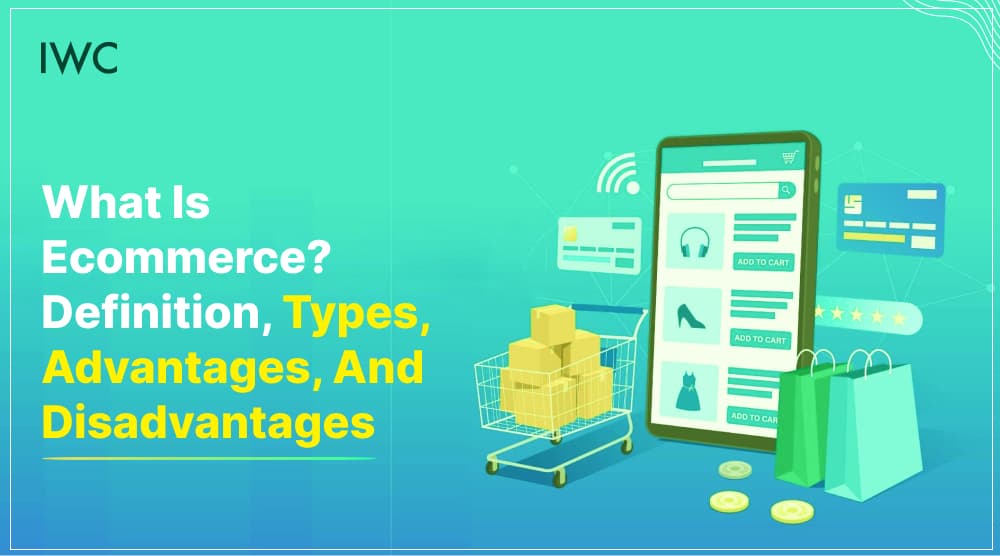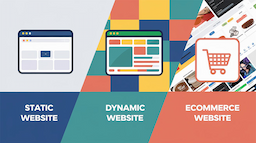eCommerce Explained: Definition, Types, Advantages, and Disadvantages

The development of the internet changed the way businesses work and people shop which ushered in e- commerce. The digital market is no longer under the shackles of geographical factors or store working hours since it has taken the form of a global phenomenon that has been enlightened through the rapid growth of technology. E-commerce is important to any individual who wishes to transact business in the 21 st century. This content will determine the definition of e-commerce, the different forms it takes, and the great benefits it poses to companies and consumers as well as the harm it causes by eCommerce development company in India.
What is E-commerce?
Electronic commerce (also written as e-commerce), simply means the purchase and sale of goods and services or the transfer of funds or data over an electronic network, usually the Internet. It covers every internet business running in the trade of goods and services. Although historically the concept of e-commerce has been used with reference to online retail stores, it is presently expanding to a colossal number of online transactions and interaction via online websites, mobile applications, as well as online marketplaces.
E-commerce is simply the practice of allowing business to go digital in order to overcome geographical boundaries to access their customers. It entails different technologies such as mobile commerce, electronic funds transfer, supply chain management, internet marketing, online transaction processing and electronic data interchange (EDI) as well as automated data collection systems.
Major features of E-commerce
Global Reach: It overrides geographical boundaries, enabling businesses to access customers globally and consumers to access products from anywhere.
24/7 Availability: Virtual stores are available 24/7, offering convenience to buyers and uninterrupted sales opportunities to businesses.
Convenience: Buyers can shop at home or on the move, comparing products and prices easily.
Personalization: Online stores can utilize data to provide individualized recommendations, offers, and shopping experiences.
Lower Overhead: For companies, e-commerce can translate into lower costs of operation compared to brick-and-mortar retailers.
Related Post: 10 Qualities of a Good eCommerce Website Design
E-commerce Business Models
There is no single form of e-commerce; it consists of a number of disparate business models depending on the participants in the transaction.
Business-to-Consumer (B2C):
Definition: The most prevalent and well-known form of e-commerce in which companies offer products or services directly to individual consumers.
Examples: Online stores such as Amazon, Flipkart, Myntra, Zomato (for food ordering), and any brand's direct-to-consumer (DTC) website.
Features: Short sales cycles, frequently impulse buying, emphasis on user experience, marketing to end-users directly.
Business-to-Business (B2B):
Definition: E-commerce transactions between two companies. This is commonly manufacturers selling to wholesalers, wholesalers selling to retailers, or companies selling services (e.g., raw materials, software) to other companies.
Examples: https://www.google.com/search?q=Alibaba.com (connecting manufacturers and wholesalers), IndiaMART (B2B portal in India), Salesforce (CRM applications for businesses).
Characteristics: Longer sales cycles, larger order sizes, usually involves complicated contracts and technical payment terms, focus on establishing long-term relationships.
Consumer-to-Consumer (C2C):
Definition: Exchanges where single consumers exchange products or services with other consumers directly, usually through a third-party platform.
Examples: OLX, Quikr (used goods classifieds), eBay (auctions and direct sales), Etsy (handmade products).
Characteristics: Platform is an intermediary, low transaction costs, wide variety of products.
Consumer-to-Business (C2B):
Definition: A reverse of B2C, where single consumers provide products or services to businesses.
Examples: Freelance websites such as Upwork or Fiverr (where one can provide skills such as graphic design, writing, coding to companies), stock photo websites (where one sells photos to companies), or promotional services provided by influencers to brands.
Features: Prices are determined by consumers, competitive rates, usually based on crowd-sourcing or individual experience.
Business-to-Administration (B2A):
Definition: Electronic transactions between public administration (government agencies) and businesses. This typically includes businesses selling goods or services to government agencies via online procurement websites.
Examples: Government contract bidders, IT solution providers to government agencies, or e-governance service providers.
Features: Very high security and compliance requirements, long approval times, emphasis on government sector requirements.
Consumer-to-Administration (C2A):
Definition: Electronic transactions between the public administration and individual consumers.
Examples: Payment of taxes online, registration for government schemes, renewal of licenses, or scheduling appointments with government services online (e.g., payment of income tax on the income tax website, application for a passport).
Features: Emphasis on convenience to the citizen, safe data transfer, uniform processes.
Benefits of E-commerce
E-commerce has many advantages that have fueled its phenomenal growth and acceptance across sectors.
For Businesses:
Global Reach & Larger Customer Base: Unlike physical stores limited by location, an online store can reach customers worldwide, 24/7. This dramatically expands potential market size.
Lower Operational Costs: E-commerce businesses can significantly reduce overheads like rent, utilities, physical security, and a large sales workforce associated with brick-and-mortar stores. This often leads to higher profit margins.
More Sales & Income: Being able to tap into an international market and being available 24/7 gives rise to greater opportunities for sales.
Data-Driven Insights: Websites and analytics solutions produce rich data on users (Browse patterns, buying history, demographics). These data are extremely useful in customized advertising, product development, and business strategy refinement.
Targeted Marketing & Personalization: With rich customer data, companies can craft super-targeted marketing campaigns and provide personalized product suggestions, resulting in greater conversion rates.
Scalability: It can also be simpler and less costly to scale an e-commerce enterprise than a brick-and-mortar one. You can grow inventory, add product lines, or manage greater traffic without having to relocate to a larger physical location.
Better Inventory Management: E-commerce systems are able to connect with inventory management software, which offers real-time information and assists businesses in maximizing stock levels and minimizing waste.
Better Customer Service: E-commerce allows for various contact channels for customer support (chatbots, email, FAQs, self-service portals) and quicker issue resolution.
Competitive Advantage: Having an online presence is practically a requirement these days. Companies that do not have one risk being left behind by competitors who have joined the digital sales bandwagon.
Faster Response to Market Trends: Businesses can quickly launch new products, test marketing campaigns, and adapt to changing consumer demands or market trends online.
Direct-to-Consumer (DTC) Model: Many brands bypass retailers and sell directly to consumers online, allowing for greater control over branding, pricing, and customer relationships.
Sustainability: For some businesses, e-commerce can contribute to sustainability efforts by reducing the need for physical infrastructure and associated energy consumption.
For Consumers:
Convenience: Shop anytime, anywhere, from any device. No travel, no queues, no parking issues.
Wider Product Selection: Consumers have access to a virtually unlimited array of products and services from various sellers globally, not just what's available locally.
Price Comparison: Easily compare prices from multiple vendors, often leading to better deals and competitive pricing.
In-depth Product Information: Web stores usually offer comprehensive product information, details, specifications, images, videos, and reviews from customers, facilitating well-informed buying decisions.
Personalized Buying Experience: Sites can retain preferences, recommend relevant products, and provide customized offers.
Accessibility: Online business provides an easy shopping facility for those with mobility problems or living in rural areas.
No Pressure Selling: Consumers are free to browse at their own pace without any salesperson pressure.
Related Post: 10 Steps to Launch Your Own Online Fashion store in 2025
Disadvantages of E-commerce
Despite its many advantages, e-commerce also comes with certain drawbacks and challenges.
For Businesses:
High Competition: The low barrier to entry means immense competition. Standing out requires significant investment in marketing, branding, and superior customer experience.
Technical Issues: Reliance on technology means vulnerability to website crashes, server downtime, payment gateway errors, and cybersecurity threats. These can lead to lost sales and reputational damage.
Cybersecurity Threats: Handling sensitive customer information (personal data, payment info) calls for strong security systems to avoid breaches, fraud, and identity theft.
Logistics and Order Fulfillment Complications: Warehousing, inventory management, shipping, and returns can prove challenging and expensive, particularly for physical goods and orders shipped across borders.
No Touch or Try-On: For items such as clothing, furniture, or electrical equipment, customers cannot touch or try the merchandise before a purchase is made, which means higher return rates.
Customer Service Expectations: Consumers expect immediate assistance. Processing queries, grievances, and exchanges through digital media can be stressful.
Reliance on Internet Connection: The customer and the business both require stable internet connection to enable transactions.
Setup Costs: While recurrent costs may be minimal, setting up an eCommerce website initially may be high, particularly for bespoke solutions or large features.
Establishing Trust: Particularly for new companies, creating trust with internet customers who are unable to physically see the store or meet employees may be a challenge.
For Consumers:
Physical Interaction: Unable to touch, feel, try on, or physically examine a product prior to purchase. A significant negative for specific product categories.
Security and Privacy Issues: Fear of exposing personal and financial details on the web, and risk of identity theft or credit card misuse.
Shipping Delays and Expenses: Products are not available at the click of a button. Shipping may be delayed, and surprise delays or high expenses can be irritating.
Returns Process: Returning products can be less than convenient, with packaging, labeling, and pickup or drop-off arrangements.
Impersonal Experience: Lack of face-to-face interaction makes the shopping experience less personal for a few.
Reliability Issues: Relying on a stable internet connection and the website itself. Slow loading speed or site crash can destroy the shopping experience.
Fraud and Scams: Possibility of coming across fraudulent websites or vendors.
The Role of an eCommerce Website Design Company
With e-commerce's complexity and potential, it comes as no surprise that most companies are cooperating with an eCommerce website design company India. The latter specializes in developing fast, secure, and intuitive online stores. Their services usually cover:
Custom Website Design & Development: Building a unique, brand-specific online storefront.
Platform Selection & Implementation: Consulting and implementing the most appropriate e-commerce platform (Shopify, WooCommerce, Magento, etc.).
UX/UI Design: Prioritizing easy navigation, engaging product presentations, and smooth checkout experiences for highest conversions.
Payment Gateway Integration: Security and varied payment method integration.
Shipping & Logistics Setup: Shipping rates, carriers, and fulfillment integration.
SEO Optimization: Developing the site following search engine best practices to be easily found.
Security Implementation: Installing SSL certificates, PCI compliance, and other security protocols.
Third-Party Integrations: Integrating with CRM, ERP, accounting, and marketing automation software.
Post-Launch Support & Maintenance: Offering continued technical support, maintenance, and performance tracking.
Collaboration with an authority can greatly speed up time-to-market, mitigate technical pains, and guarantee the website is constructed for long-term online success.
Conclusion
E-commerce has deeply reshaped the world marketplace, providing unprecedented convenience, access, and analytics-driven insights. To businesses, it offers opportunities to wider markets and lower costs of operation, but to consumers, it offers an unprecedented range of choice and shopping convenience. Success, though, in this competitive field calls for a very good understanding of its different types and a strategic response to combating its built-in risks, including intense competition, technical dependencies, and security issues. By weighing the pros and cons judiciously and seeking the services of an eCommerce website development company where necessary,
At IWC, we are a leading AI based eCommerce development company in India, helping businesses build powerful eCommerce websites and mobile apps. Our AI-Based eCommerce solutions are designed to boost sales, enhance customer experience, and grow your online presence.
Recent Blogs

Static vs. Dynamic vs. eCommerce Websites: Understanding the Key Differences

Your 10-Step Blueprint to Launching a Successful Online Fashion Store
